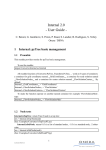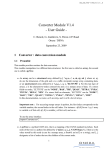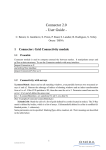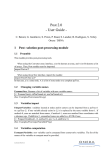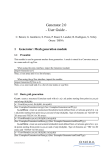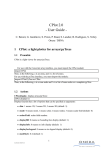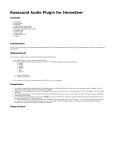Download Distributor2 2.0 - User Guide - - elsA
Transcript
Distributor2 2.0 - User Guide C. Benoit, G. Jeanfaivre, S. Peron, P. Raud, S. Landier, B. Rodriguez, S. Verley Onera / DSNA 1 Distributor2: block distribution module 1.1 Preamble To use the module with the Converter array interface, you must import it as: import Distributor2 as D2 To use the module with the pyTree interface, you must import it as: import Distributor2.PyTree as D2 1.2 Automatic load balance D2.distribute: distribute automatically the blocks amongst N processors. With the array interface, where A is a list of blocks: - prescribed is a list of blocks that are forced to be on a given processor. prescribed[2] = 0 means that block 2 MUST be affected to processor 0. - perfo is a tuple or a tuple list for each processor. Each tuple describes the relative weight of solver CPU time regarding the communication speed and latence (solverWeight, latenceWeight, comSpeedWeight). - weight is a list of weight for each block indicating the relative cost for solving each block. - com is a ixj matrix describing the volume of points exchanged between bloc i and bloc j. Algorithm can be chosen in: ’gradient’, ’genetic’, ’fast’. The function output is a stats dictionary. stat[’distrib’] is a vector describing the attributed processor for each block, stats[’meanPtsPerProc’] is the mean number of points per proc, stats[’varMin’] is the minimum variation of number of points, stats[’varMax’] is the maximum variation of number of points, stats[’varRMS’] is the mean variation of number of points, stats[’nptsCom’] is the number of points exchanged between processors for communication, stats[’comRatio’] is the ratio of points exchanged between processors in this configuration divided by the total number of points needed in communications, stats[’adaptation’] is the value of the optimized function: 1 /ELSA/MU-12016/V2.0 stats = D2.distribute(A, N, prescribed=[], perfo=[], weight=[], com=[], algorithm=’gradient’) With the pyTree interface, the user-defined node .Solver#Param/proc is updated with the attributed processor number. If useCom=0, only the grid number of points is taken into account. If useCom=’all’, matching and overlap communications are taken into account. If useCom=’match’, only match connectivity are taken into account. if useCom=’overlap’, only overlap connectivity are taken into account. if useCom=’bbox’, overlap between zone bbox is taken into account. When using distributed trees, prescribed must be a dictionary containing the zones names as key, and the prescribed proc as value. t must be a skeleton or a loaded skeleton tree for useCom=0 or useCom=’match’, but must be a loaded skeleton tree only for the other settings: t, stats = D2.distribute(t, N, prescribed=, perfo=[], useCom=’all’, algorithm=’gradient’) (See: Examples/Distributor2/distribute.py) (See: Examples/Distributor2/distributePT.py) D2.getProcDict: return a dictionary proc[’blocName’] identifying the attributed processor for a given bloc name. If prefixByBase is True, then the dictionary is proc[’baseName/blocName’]. A must be an already distributed tree: procDict = D2.getProcDict(A, prefixByBase=False) (See: Examples/Distributor2/getProcDictPT.py) D2.redispatch: redispatch a tree where a new distribution is defined in the node ’proc’: B = D2.redispatch(A) (See: Examples/Distributor2/redispatchPT.py) 1.3 Example files Example file : Examples/Distributor2/distribute.py # - distribute (array) import Generator as G import Distributor2 as D2 import numpy # Distribution sans communication entre blocs N = 11 arrays = [] for i in xrange(N): a = G.cart( (0,0,0), (1,1,1), (10+i, 10, 10) ) arrays.append(a) out = D2.distribute(arrays, NProc=5) ; print out # Distribution avec des perfos differentes pour chaque proc out = D2.distribute(arrays, NProc=3, perfo=[(1,0,0), (1.2,0,0), (0.2,0,0)]) ; print out # Distribution avec forcage du bloc 0 sur le proc 1, du bloc 2 sur le proc 3 # -1 signifie que le bloc est a equilibrer prescribed = [-1 for x in xrange(N)] prescribed[0] = 1 ; prescribed[2] = 3 out = D2.distribute(arrays, NProc=5, prescribed=prescribed) ; print out # Distribution avec communications entre blocs, perfos identique pour tous # les procs 2 /ELSA/MU-12016/V2.0 volCom = numpy.zeros( (N, N), numpy.int32 ) volCom[0,1] = 100; # Le bloc 0 echange 100 pts avec le bloc 1 out = D2.distribute(arrays, NProc=5, com=volCom, perfo=(1,0.,0.1)) ; print out # Distribution avec des solveurs differents pour les blocs (le solveur est 2 # fois plus couteux pour les bloc 2 et 4) out = D2.distribute(arrays, weight=[1,2,1,2,1,1,1,1,1,1,1], NProc=3) ; print out Example file : Examples/Distributor2/distributePT.py # - distribute (pyTree) import Generator.PyTree as import Distributor2.PyTree import Converter.PyTree as import Connector.PyTree as G as D2 C X N = t = pos for 11 C.newPyTree([’Base’]) = 0 i in xrange(N): a = G.cart( (pos,0,0), (1,1,1), (10+i, 10, 10) ) pos += 10 + i - 1 t[2][1][2].append(a) t = X.connectMatch(t) t, stats = D2.distribute(t, 3) C.convertPyTree2File(t, ’out.cgns’) Example file : Examples/Distributor2/getProcDictPT.py # - getProcDict (pyTree) import Generator.PyTree as import Distributor2.PyTree import Converter.PyTree as import Connector.PyTree as N = t = pos for G as D2 C X 11 C.newPyTree([’Base’]) = 0 i in xrange(N): a = G.cart( (pos,0,0), (1,1,1), (10+i, 10, 10) ) pos += 10 + i - 1 t[2][1][2].append(a) t = X.connectMatch(t) t, stats = D2.distribute(t, 3) proc = D2.getProcDict(t) zoneNames = C.getZoneNames(t, prefixByBase=False) for z in zoneNames: print z, proc[z] # - or with base prefix proc = D2.getProcDict(t, prefixByBase=True) zoneNames = C.getZoneNames(t, prefixByBase=True) for z in zoneNames: print z, proc[z] Example file : Examples/Distributor2/redispatchPT.py # - redispatch import Converter.PyTree as C import Distributor2.PyTree as D2 import Distributor2.Mpi as D2mpi import Converter.Mpi as Cmpi import Transform.PyTree as T 3 /ELSA/MU-12016/V2.0 import Connector.PyTree as X import Converter.Internal as Internal import Generator.PyTree as G # Case N = 11 t = C.newPyTree([’Base’]) pos = 0 for i in xrange(N): a = G.cart( (pos,0,0), (1,1,1), (10+i, 10, 10) ) pos += 10 + i - 1 t[2][1][2].append(a) t = X.connectMatch(t) if (Cmpi.rank == 0): C.convertPyTree2File(t, ’in.cgns’) Cmpi.barrier() # lecture du squelette a = Cmpi.convertFile2SkeletonTree(’in.cgns’) # equilibrage 1 (a, dic) = D2.distribute(a, NProc=Cmpi.size, algorithm=’fast’, useCom=0) # load des zones locales dans le squelette a = Cmpi.readZones(a, ’in.cgns’, proc=Cmpi.rank) # equilibrage 2 (a partir d’un squelette charge) (a, dic) = D2.distribute(a, NProc=Cmpi.size, algorithm=’gradient1’, useCom=’match’) a = D2mpi.redispatch(a) # force toutes les zones sur 0 zones = Internal.getNodesFromType(a, ’Zone_t’) for z in zones: nodes = Internal.getNodesFromName(z, ’proc’) Internal.setValue(nodes[0], 0) a = D2mpi.redispatch(a) # Reconstruit l’arbre complet a l’ecriture Cmpi.convertPyTree2File(a, ’out.cgns’) 4 /ELSA/MU-12016/V2.0




